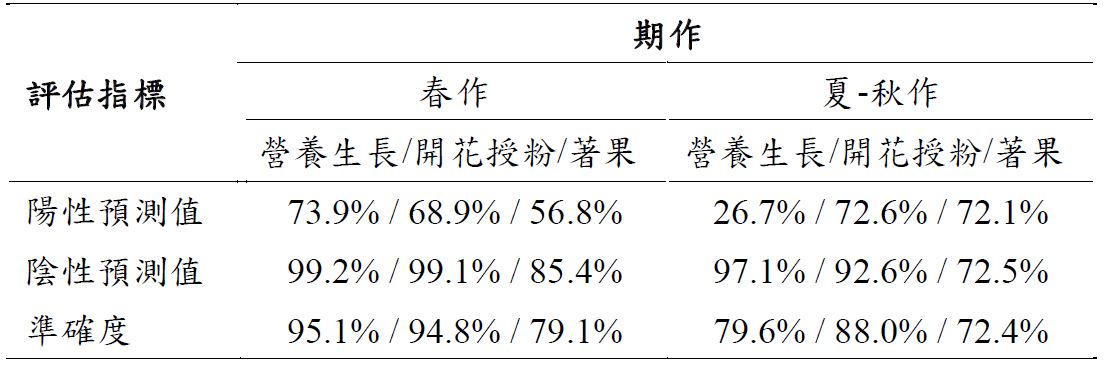- Demonstration of Multiple Recycling of Mushroom Materials to Drive Sustainable Production
- Optimization and Diffusion of Onion Healthy Seedling and Tomato Cultivation Adjustment Technology
- Establishment of Seed and Seedling Carbon Footprint Product Category Rules (PCR) Assessment
- Promoting to Popular Application of Intelligent Production and Sales Management in Vegetable Nurseries
- Research on Propagation Technology of Indigenous Taro Seedlings
- The Promotion of Conservation systems and the assessment of applications for indigenous heirloom foxtail millet(Setaria italia)
- Establishment and Verification of the Optimal Irrigation Mode for Melon in Protected Facility
- Counseling on Digital Transformation of Small,Medium and Micro-sized
- Establishment of Important Virus Detection Method for Grape in Taiwan
- Restablishment of Domestic Seed Corn and Sorghum Production System
- Construction of Environmental Verification System and Standards for Cucurbits Nurseries
- Promotion of Crop Healthy Germplasm Conservation and Propagation System
- Research on the New Development Trend of Seed Treatment Technology
- Study on Condition of Seed Storage for Food Crops
- Study on Tomato Rootstock Resistance to Bacterial Wilt and Implementation of Field Management Strategies in Seedling Nurseries
- Development and Application of Molecular Markers Associated with Anti-fusarium Wilt on Luffa and Drought-tolerance and Other Important Traits on Maize
- Analysis and application of root‐associated microbes from soil-borne disease resistant and sensitive lines of Solanaceae crops
- Development of Key Technologies for Tissue Culture-assisted Seed Selection
- Developing of crops novel assisted breeding technology on melon
- Research on germplasm maintenance and industrial application of vegetative propagation crops
- Germplasm Development and Application of Aeridinae Orchids and Cattleya Alliance.
- The Promotion of Aboriginal Beans Crops Seed Saving System
- Research on Genetic Resources and DUS Testing Techniques Management and Application for Economical and Special Crops
- Next-generation Ark of Agriculture and Forestry Germplasm - Germplasm Regeneration of Important Cross-Pollinated Crops.
- Construction of Certification System and Demonstration Field for Organic Rice and Upland Crop Seed
- Evaluation of soybean rotation model by organic cultivation management model.
- Techniques Development for Bulb Flowers Breeding
- Establishment of the Heat-Resistant Selection Index and Breeding of Tomato
- High Quality and Stress Tolerance Breeding in Tomato.
- Establishing Cucurbitaceae Vegetables New Varieties of Heat Tolerance and Related Technology
- Breeding of New Papaya Variety for the International Industry
- A Study on the Well-being Benefits of Horticultural Therapy for Elderly Residents in the Central Region.
- Research on the Behavioral Intentions of Agricultural Social Responsibility
- Research on the Development and Application of Diverse Food and Agriculture Teaching Materials of Potato
- Nutritional Function Analysis and Processing Technique Optimization of Ginger
- Application Evaluation of Taro Diversified Processing Raw Materials
- Study of Inspection and Monitoring System for Gene-edited and Genetically Modified crops
- Enhancing the Connection and Participation with Seed Testing Technology Related International Organization
 Home > Achievement > 2024Research Project List > Establishment and Verification of the Optimal Irrigation Mode for Melon in Protected Facility Home > Achievement > 2024Research Project List > Establishment and Verification of the Optimal Irrigation Mode for Melon in Protected Facility |
Establishment and Verification of the Optimal Irrigation Mode for Melon in Protected Facility
Melon (Cucumis melo L.) is one of the important fruits cultivated in Taiwan. Proper water management significantly impacts both the production and quality of melons. During the period of 2022- 2023, this project developed a model for evaluating the water status of melon ’Jia-Yu’, crop coefficients for each growth stage, water use coefficients for key production areas, crop coefficients of Penman–Monteith equation in soil cultivation, and timing for seedling water supply. This year, field verification of these models was carried out. The water status evaluation model was used to assist in determining irrigation timing, while crop coefficients were applied using the reference evapotranspiration-crop coefficient procedure (ET0-Kc procedure) to estimate the crop's water requirements. The results showed that applying the ET0-Kc procedure in combination with post-fruit reduction irrigation could reduce water usage in seedling farms by approximately 19.3% for spring crops and 25.7% for summer-autumn crops without compromising fruit quality (including fruit weight, length, width, flesh thickness, sweetness, and cracking rate). On the other hand, applying the melon water status evaluation model to seedling farm cultivation conditions showed that the model's negative predictive value and accuracy were at an acceptable to good level, though the positive predictive value was somewhat low. Future modifications to the model could improve the balance between predicting positive (water shortage) and negative (normal) conditions. Regarding soil irrigation water use information, during the high temperature summer cultivation period, reducing irrigation resulted in a significant decrease in yield. However, reducing irrigation by 20% in autumn cultivation increased sugar content, and reducing water supply by 40% could improve the good fruit rate to 71%. This suggests that appropriate water-saving strategies should be considered for autumn production.
 ▲Fig.1. ET0-Kc procedure off-site verification results in 2024. |
 ▲Fig.2. Field validation water status evaluation model performance in 2024. |
 ▲Fig.3. Estimated water consumption per hectare for melon cultivation during the entire growth period in 2014. (green dots: water consumption for conventional cultivation; red dots: 20% reduction in water consumption; blue dots: 40% reduction in water consumption) |
 ▲Fig.4. The melon fruit characteristics of the first crop. |
 ▲Fig.5. The melon fruit characteristics of the second crop. |
